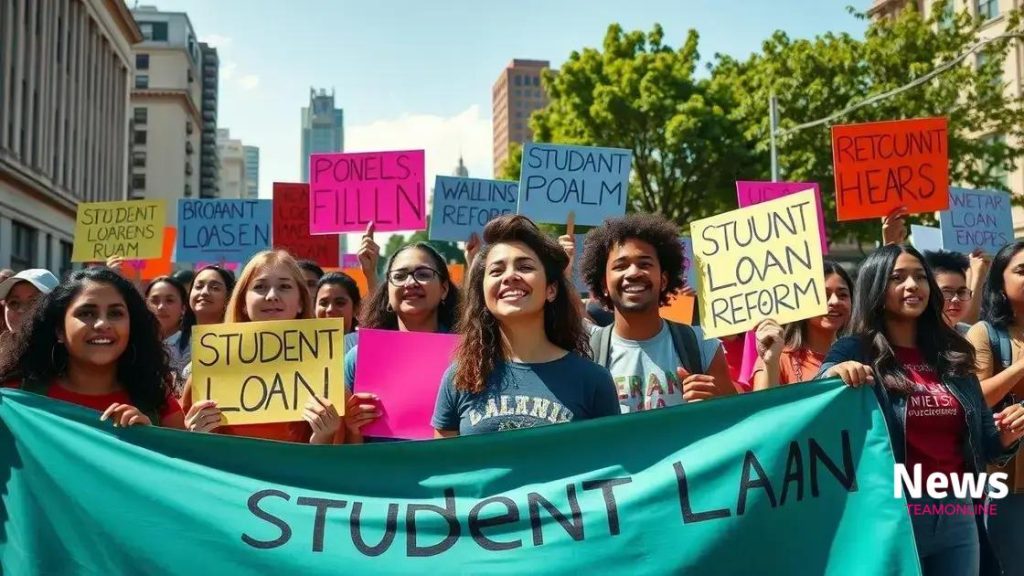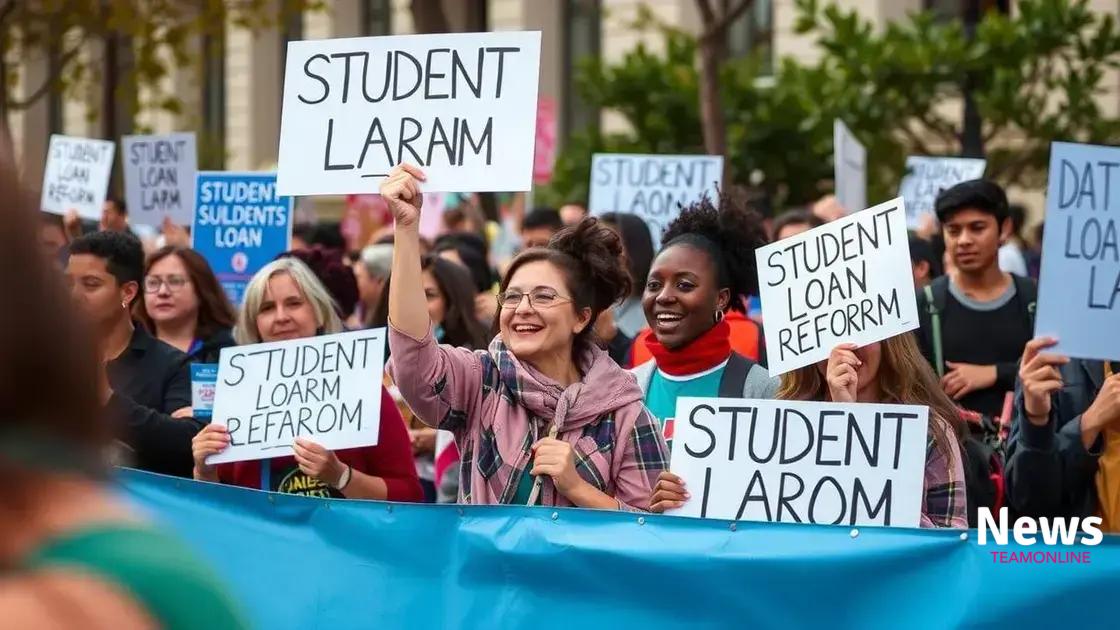Rise in activism over student loan burdens

The rise in activism over student loan burdens has led to increased advocacy for reforms such as debt forgiveness, lower interest rates, and better repayment options to alleviate the financial strain on borrowers.
Rise in activism over student loan burdens has sparked a significant conversation across campuses and communities. Many young graduates are questioning how to navigate their futures while laden with debt, raising important issues that affect us all.
Understanding student loan burdens
Understanding student loan burdens is crucial for many graduates today. With the rising costs of education, more students are taking on debt to finance their degrees. This phenomenon has led to a growing concern about the impact of student loans on young adults and their future financial health.
The Basics of Student Loans
Student loans come in various forms, including federal and private loans. Federal loans often have lower interest rates and more flexible repayment options. Private loans, on the other hand, can vary widely in terms of interest rates and terms.
Common Challenges Faced by Borrowers
Many borrowers struggle to manage their loans after graduation. Some of the major challenges include:
- High monthly payments that strain budgets.
- Long repayment terms that can last for decades.
- Interest accumulating quickly, increasing total loan amounts.
- Difficulty in finding jobs that pay enough to cover living expenses and loan payments.
With these challenges, it’s no surprise that many graduates feel overwhelmed and anxious about their future. Understanding the specifics of student loans is a critical first step in managing this burden effectively.
Another key aspect is the role of interest rates. The rates on student loans can significantly affect the total amount repaid over time. Borrowers must be aware of their rates and consider options for refinancing or consolidating loans if it makes financial sense.
Options for Relief and Support
Fortunately, there are options available for individuals struggling with student loan debt:
- Income-driven repayment plans that adjust payments based on income.
- Loan forgiveness programs for those in public service careers.
- Scholarships and grants that can help reduce the total borrowing needed.
In conclusion, recognizing the complexities of student loan burdens is essential. By staying informed and exploring available options, borrowers can navigate this challenge more effectively and work towards a more stable financial future.
The rise of advocacy groups
The rise of advocacy groups has become a prominent response to the burden of student loans. These organizations are dedicated to raising awareness and fighting for changes in policies that affect borrowers. By uniting individuals and groups, they create a powerful voice that calls for reforms and support.
Key Advocacy Groups Making a Difference
Several advocacy groups have emerged, focusing on relieving student debt and educating the public. Notable organizations include:
- Student Debt Crisis: This group highlights personal stories and pushes for comprehensive reforms.
- Young Invincibles: They focus on economic issues affecting young adults, including student loans.
- National Student Loan Borrower Defense Coalition: They advocate for policy changes to protect borrowers from predatory lending practices.
These groups leverage social media and grassroots campaigns to spread their messages widely. They help connect borrowers to resources and provide platforms for their stories to be heard. Advocacy efforts have gained momentum, reflecting a growing frustration with the current student loan system.
The Impact of Social Media on Advocacy
In today’s digital age, social media plays a crucial role in mobilizing support and spreading information. Advocacy groups effectively use platforms like Twitter and Facebook to engage younger audiences. These platforms allow for real-time updates and mobilization during critical moments, such as protests or legislative discussions.
Social media also facilitates sharing personal experiences, which helps humanize the issue of student debt. As stories circulate, they raise awareness and encourage others to join the cause. This collective action helps demonstrate the urgency of addressing student loan burdens.
Through persistent efforts and collaboration among advocacy groups, there is hope for significant policy changes. The rise of these organizations not only empowers borrowers but also influences lawmakers to consider reforms that impact millions.
Effective campaigns and their impact

Effective campaigns and their impact play a crucial role in addressing the issue of student loan burdens. These campaigns aim to raise awareness, mobilize supporters, and drive policy changes that benefit borrowers. By utilizing various strategies, these campaigns strive to create meaningful dialogue around student debt.
Strategies for Successful Campaigns
To make an impact, advocacy campaigns often employ a variety of tactics:
- Grassroots Mobilization: Engaging communities and encouraging individuals to share their stories.
- Digital Advocacy: Using social media platforms to reach a wider audience and facilitate discussions.
- Partnerships: Collaborating with organizations, colleges, and businesses to amplify messages.
These strategies ensure that campaigns resonate with both borrowers and policymakers, fostering a sense of urgency that leads to action. Additionally, leveraging the power of personal stories helps humanize the impact of student debt, creating emotional connections.
Measuring Campaign Impact
It is essential to evaluate the success of campaigns. Some measurable outcomes include:
- Increased public awareness about student debt issues.
- Changes in policy or legislation related to student loans.
- Growth in public support for debt forgiveness initiatives.
By tracking these metrics, advocacy groups can refine their approaches and focus their efforts on strategies that yield the best results. Effective campaigns often inspire others to take action and contribute to the growing movement.
Additionally, competitive analysis of similar campaigns can provide insights into what resonates with audiences. Learning from others’ successes and challenges can lead to more innovative ideas and strategies in addressing student loan burdens.
Personal stories of struggle
Personal stories of struggle highlight the human side of student loan burdens. Each story reflects the challenges faced by graduates, demonstrating the emotional and financial impact of debt. By sharing these experiences, individuals can connect with others and inspire collective action.
Impact of Student Loans on Daily Life
Many graduates experience stress as they manage their student loans. This burden can affect their career choices, relationships, and mental health. Some graduates delay major life events, such as buying a home or starting a family, because of financial constraints. These stories often reveal the unintended consequences of taking on debt for education.
Examples of Student Loan Experiences
Several common themes emerge from personal accounts:
- Financial Anxiety: Many individuals feel constant worry about making loan payments.
- Job Market Challenges: Graduates struggle to find jobs that pay enough to cover their debts.
- Emotional Toll: The pressure of repayment can lead to feelings of guilt and failure.
These narratives underscore the importance of understanding student loans not just as numbers, but as factors that deeply influence lives. Sharing personal stories can also foster a supportive community where individuals feel less isolated in their struggles.
Turning Struggles into Advocacy
As these stories are shared, many individuals transform their experiences into advocacy efforts. Some become involved in campaigns to help others facing similar circumstances. By speaking out, they raise awareness and push for important policy changes. Their voices contribute to a larger conversation about the need for reforms in student loan systems.
Ultimately, when personal struggles are shared, it can create a powerful movement. These stories help others realize they are not alone and inspire action toward making meaningful changes in the education financing landscape.
Future outlook on student loan reforms
The future outlook on student loan reforms is a topic of great interest and concern among borrowers and policymakers. As more individuals voice their struggles with debt, the push for effective reforms is gaining momentum. Many believe changes are necessary to create a fairer and more manageable system.
Current Proposals for Reform
There are several key proposals currently being discussed that aim to alleviate the burdens of student loans:
- Debt Forgiveness Programs: Many advocates are pushing for widespread loan forgiveness, particularly for low-income borrowers or those in public service roles.
- Interest Rate Reductions: Proposals include lowering federal loan interest rates to make repayments more affordable.
- Income-Driven Repayment Plans: Expanding eligibility for income-driven repayment options could help borrowers manage their debt based on their earnings.
These proposals represent significant steps toward addressing the issues associated with student loans. Each idea aims to reduce the financial strain on borrowers, making education more accessible.
The Role of Advocacy in Shaping Reforms
Advocacy groups continue to play a critical role in shaping the future of student loan reforms. They engage in grassroots campaigns, conduct research, and collaborate with lawmakers to ensure that the voices of borrowers are heard. Their efforts help to keep this issue in the public eye and prompt discussions about potential changes.
Engagement from graduates and current students is essential for creating impactful reforms. Personal stories shared on social media and during rallies highlight the urgent need for change. As more individuals get involved, the possibility of enacting these proposals increases.
Moving forward, it is essential for lawmakers to consider the diverse experiences of borrowers when crafting reforms. A comprehensive approach can lead to policies that not only help current borrowers but also prevent future generations from facing similar challenges.
In conclusion, the rise in activism over student loan burdens highlights a critical issue affecting many individuals today. Advocacy groups are working tirelessly to bring about necessary reforms, and personal stories of struggle resonate deeply, adding urgency to the conversation. With proposed changes on the horizon, including debt forgiveness and lower interest rates, there is hope for a more manageable future. As more people engage in this important dialogue, the potential for impactful reforms continues to grow, paving the way for a brighter future for student loan borrowers.
FAQ – Frequently Asked Questions about Student Loan Burdens
What are student loan burdens?
Student loan burdens refer to the financial strain that borrowers experience due to their student debt, which can affect their daily life and future plans.
How do advocacy groups help borrowers?
Advocacy groups work to raise awareness, push for policy changes, and provide support for individuals struggling with student debt.
What reforms are currently being discussed?
Proposed reforms include debt forgiveness programs, lowering interest rates, and expanding income-driven repayment plans.
How can I get involved in advocacy for student loan reform?
You can get involved by sharing your story, joining advocacy groups, participating in campaigns, and staying informed about legislative changes.





